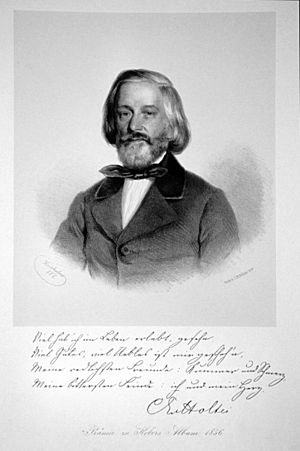Kommt ein Vogel geflogen facts for kids
Quick facts for kids "Kommt ein Vogel geflogen" |
|
|---|---|
| Volkslied, love song | |

Von Holtei in 1856
|
|
| English | "Comes a bird flown" |
| Written | 1824 |
| Text | by Karl von Holtei |
| Composed | 19th century or earlier |
"Kommt ein Vogel geflogen" ("Comes a Bird Flown") is a very old and popular German Volkslied, which means "folk song." It started as a love song from a region in Austria called Lower Austria. People sang it for many years before it was written down.
The first parts of the song appeared in print in 1807. Later, in 1824, a writer named Karl von Holtei included six verses in his play. This play helped make the song very famous. Over time, the song's words changed, and it became a popular children's song. A composer named Siegfried Ochs even created funny musical versions of the song for piano. He made them sound like different famous composers had written them.
Contents
A Song's Journey: From Love to Lullaby
The Original Love Song
The original words of "Kommt ein Vogel geflogen" were first printed in 1824 in a play by Karl von Holtei. This play was called Posse mit Gesang, which means "Farce with Songs." Holtei wrote the play using a special Austrian way of speaking, called a dialect.
It's not fully known which parts of the song Holtei added himself. However, the fifth verse was most likely written by him. This is because it only makes sense when you know the story of his play. The second verse was often left out in later versions of the song.
What the Original Song Was About
The original song from the 1800s was about a young person talking to their sweetheart. The words "Diandl" and "Schatzerl" in the song are old German words for a girlfriend or darling.
Here are the original words of the song:
Kimmt a Vogerl' geflogen,
Setzt si nieder auf mein Fuß,
Hat a Zetterl im Goschl
Und vom Diandl an'n Gruß.
Und a Büchserl zum Schießen
Und an Straußring zum Schlag'n,
Und a Diandl zum Lieben
Muß a frischer Bub' hab'n.
Hast mi allweil vertröstet
Auf die Summeri-Zeit;
Und der Summer is kumma,
Und mei Schatzerl is weit.
Daheim is mei Schatzerl,
In der Fremd bin ich hier,
Und es fragt halt kei Katzerl,
Kei Hunderl nach mir.
In der Fremd' sein d' Wiena
Und d' Wiena sein harb,
Machen traurige Mienen,
Weil's Muetterli starb.
Liebes Vogerl flieg weiter,
Nimm Gruß mit und Kuß!
Und i kann di nit begleit'n,
Weil i hier bleiben muß.
Many versions of the song from the 1800s were based on Holtei's play.
Becoming a Children's Song
Around 1911, the words of the song started to change. Instead of talking to a sweetheart, the song began to talk to a mother. This made it perfect for children. For example, it was used in a musical play for children by Johann Lewalter and Georg Schläger.
Here are the words of the children's version:
Kommt ein Vogel geflogen,
setzt sich nieder auf mein' Fuß,
hat ein' Zettel im Schnabel,
von der Mutter ein' Gruß.
Lieber Vogel, fliege weiter,
nimm ein Gruß mit und ein Kuss,
denn ich kann dich nicht begleiten,
weil ich hier bleiben muss.
Fun Musical Versions
Siegfried Ochs was a composer who wrote special musical versions of "Kommt ein Vogel geflogen" for the piano. These were called "variations." He made them sound like famous composers such as Johann Sebastian Bach, Wolfgang Amadeus Mozart, Ludwig van Beethoven, and Richard Wagner had written them. These funny variations were also arranged for a full orchestra.
The song was recorded in 1969 by the Nordwestdeutsche Philharmonie orchestra, led by Werner Andreas Albert.

